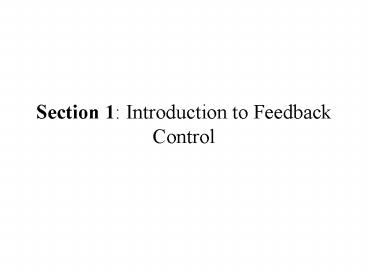Section 1: Introduction to Feedback Control - PowerPoint PPT Presentation
1 / 22
Title:
Section 1: Introduction to Feedback Control
Description:
stable if there is a dissipative Lyapunov function for the system (a ... System is detectable if: output tends to equilibrium implies state tends to equilibrium ... – PowerPoint PPT presentation
Number of Views:30
Avg rating:3.0/5.0
Title: Section 1: Introduction to Feedback Control
1
Section 1 Introduction to Feedback Control
2
Dynamical Models
Dynamics
State space
3
Ordinary Differential Equations
- Linear
- Superposition, limited behaviour
- Nonlinear
- No superposition, wide range of behaviour
4
Ordinary Differential Equations
Phase portraits
Linear
Nonlinear
5
Linearization
6
Notions of Stability
- (neutral) stability asymptotic stability
7
Regions of Stability
- local stability global
stability
8
Tests for Stability
Linear system asymptotically stable if
eigenvalues of A have negative real part (we say
A is Hurwitz)
- Nonlinear system
- stable if there is a dissipative Lyapunov
function for the system (a generalized energy)
9
Control Differential Equations
Linear
Nonlinear
- The input u may include
- a disturbance acting on the system
- a reference signal to be tracked
- a control input to be chosen by the system
designer
(Here we think of the output as the whole state x)
10
Feedback Control
Linear System
- Open loop system
- Feedback control
- Closed loop system
11
Allosteric Control
Control Input (u2)
Input (u1)
X
X
X
X
Output
0
1
i
n
Set u2 - Xn
Feedback
Input (u1)
X
X
X
X
Output
0
1
i
n
12
Controllability and Stabilizability
- System is controllable if for every pair of
points x1 and x2 there is an input u(t) which
drives the system from x1 to x2
- System is stabilizable if for every point x1
there exists an input u(t) which drives the
system to an equilibrium
13
Controllability of Biochemical Networks
Control Input (u)
Glycolytic chain
Input (glucose)
Output (ATP)
X
X
X
X
0
1
i
n
Pentose pathway
Output (pentose)
Z1
Zn
ATP is controllable with input u Pentose is
not controllable with input u Pentose is
stabilizable with input u
14
Systems with Outputs
- The output y is commonly a subset of the
components of the state . - The output may represent
- the part of the state which is of interest
- a measurement of the state
15
Observability and Detectability
- System is observable if the state trajectory x(t)
can be determined from the output trajectory y(t) - System is detectable if output tends to
equilibrium implies state tends to equilibrium
16
Observability of Biochemical Networks
Trivial (static) example system involving AMP,
ADP, ATP, no change in level of adenosine moiety
AMP observable through ADP and ATP
Dynamic example
Feedback
Input (u)
Xn1
X
X
X
X
0
1
i
n
Full state observable from y (X0, X3, X6, Xn)
and input u.
17
Frequency Domain Fourier Series
18
Frequency Domain Fourier Transform
19
Laplace Transform
- Laplace Transform
Determines the frequency content of the signal
f(t). Crucial feature Laplace transform of a
differential equation is an algebraic equation
Differential Equation
Solution
Inverse Laplace Transform
Laplace Transform
Transformed Solution
Algebraic Equation
20
Transfer functions
- In frequency space a linear time-invariant
(LTI) system acts by multiplication
U(s)
Y(s)
H(s)
Y(s) H(s) U(s)
Satisfies superposition
Y1(s) H(s) U1(s) and Y2(s) H(s) U2(s)
imply Y1(s) Y2(s) H(s) U1(s) U2(s)
21
Frequency Response Bode Plots
Superposition a plot of system response versus
frequency completely characterizes the system
22
Feedback provides Robustness
system
No feedback
-
Feedback

